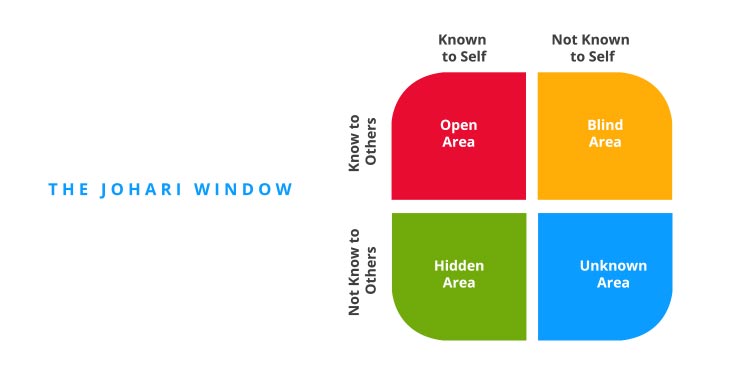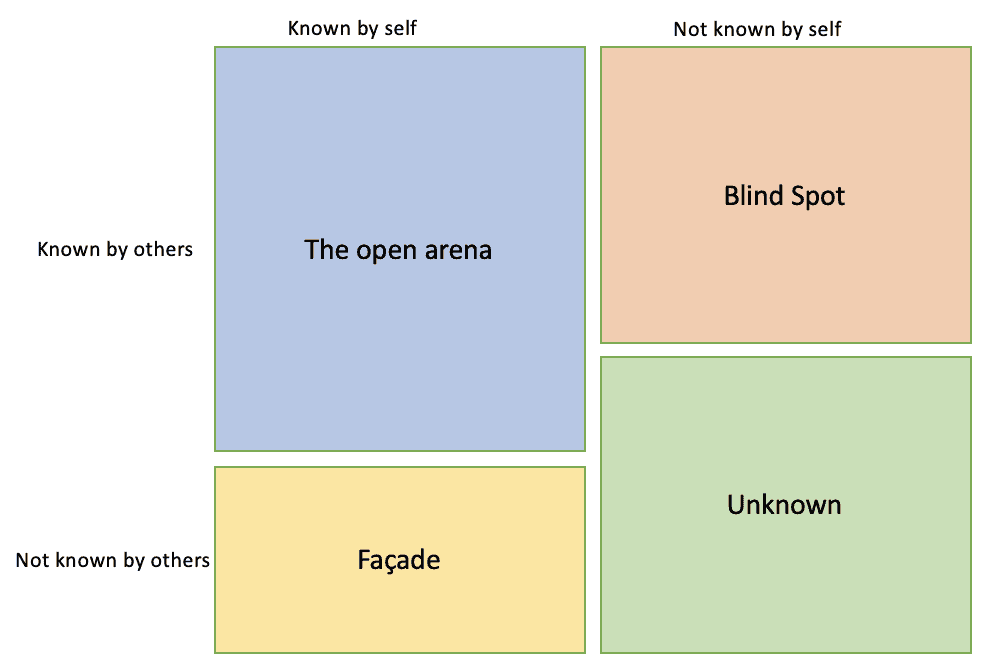In hopes of going up the career ladder, we focus a lot on learning and acquiring technical skills. But sometimes when we have to give a business presentation in front of a big crowd, we often find ourselves stressed and anxious. We get nervous when the audience gives us blank stares or lets out a yawn. It makes us feel that our presentation was boring or it wasn’t communicated effectively.
What if there was a model that can help you improve your soft skills? Well, turns out there is one. It’s called the Johari Window model.
in this article, we will explore this model in-depth and see how well it can be used to upgrade our soft skills.
What is the Johari Window?
Johari Window is a psychological tool that helps people understand the emotional and physical relationship with self and others. This technique can be used in a self-help context, corporate environment, or group setting.
This concept was put forward by American psychologists Joseph Luft and Harrington Ingham in 1955.
This concept is used to improve an individual’s perception of others. It is based on two ideas:
- You can acquire trust by revealing your information to others
- Learn about yourself from others’ feedback about you
Let’s move on to discuss the Johari window model in detail.
The Johari Window Model
This model does a fairly good job of interpreting feedback. It represents a window with four panes. Two of the panes represent self while the other two signifies parts that are known to others and not yourself. Information transfers from one pane to another as a consequence of the mutual trust that members share with each other. This trust is achieved through socializing and the feedback members got from each other.
Confused? Let’s deep dive into each pane separately.

Open Area/Arena
This pane represents information that is known to the individual and those around them. This information includes the person’s attitudes, feelings, emotions, attitude, behavior, skills, and views. This is where communication occurs. The larger this area, the more dynamic and effectual the relationship between the subject and others.
Blindspot
Information in this quadrant is known to others but not to the subject. People may know this information in groups but the subject is unaware of it. This often becomes a barrier to self-awareness. For example, while giving a speech you may be unaware of some physical and unconscious habits such as putting your hands in the pocket or avoiding eye contact with the audience. These are some of the non-verbal cues that others will notice about you without you realizing them yourself.
Information in this quadrant is helpful in getting 360-degree reviews and professional and personal development. This is because this information can either be positive or negative. It can either highlight strengths or areas of improvement.
Eventually, the aim is to decrease blind spots as much as possible.
Hidden Area/Facade
Information in this quadrant is known to the subject but not others. This information includes secrets, past experiences, fear, opinions, and views.
Subject chooses to keep certain information to themselves for two reasons: Either it is too personal or they fear that they might be judged or receive negative reactions. The more the trust, the mere personal information will be shared with others. As a result, the hidden area will decrease and the open area will increase as shown below.

Unknown
This is the last quadrant of the model and represents information that is unknown to the subject and others around them. The information includes talents, skills, childhood memories, etc. The subject will remain unaware until their hidden qualities or capabilities are observed and discovered by others. Similarly, others will remain unaware of certain aspects until the subject makes an effort to have open communication with them.
Uses of Johri Window Model
The Johari window model can be used for personal as well as professional goals. It is used for understanding and improving the following;
- Improving communications
- Interpersonal relationships
- Group dynamics
- Self-awareness
- Personal development
- Team development
- Intergroup relationships
Johari Window Model Improves Communication
There are a few steps that you have to go by in order to make the best use of this model to bridge the communication gap within your team. Let’s go by each of them individually.
Educate
If you aim to improve communication within your team members the first step is to educate them. Let them know the reason for conducting this exercise, what expectations do you have from them and what goals do you wish to achieve by the end. Laying everything out beforehand will reduce ambiguity and eases out the process.
Open Up
Once you have shared all the details about the technique, it is time to get everyone to think about how they see themselves and others. This will be helpful when people will move on to pick adjectives and work towards the open arena of the model.
A good starting point would be to encourage others to begin by sharing small details about themselves. Sharing small details help build trust and breaks the barrier to communication.
As everyone starts to open up more, people can jump on to sharing larger things such as feelings, emotions, and ambitions. By now people everyone will be at ease with each other and have a better idea about one another.
However, it is important to note that you don’t have to force people to share personal details or secrets about each other. What they have shared is sufficient to open communication channels and build trust with another.
Encouragement
Here, you would want to encourage your team to provide feedback. This will ensure that things that fell into the blindspot are addressed and those in the open arena stay open.
Reflection
After the completion of this exercise, all the participants should reflect on the feedback they received from one another. It is also important that team members reflect on how the exercise helped them build trust and communicate with each other.
Johari Window Model Builds Better Teams
You can also use Johari Window Model as a team-building tool.
Team members can participate in the exercise by placing and matching different adjectives in different quadrants. This helps them discover attributes about themselves and others.
The eventual goal of this exercise is to enlarge the open arena. This will happen when the subject will open up and share details about themselves. Eventually, their hidden area on the matrix will decrease. This will be followed by the subject receiving feedback from other team members which will help minimize the blind spot.
As team members go through this exercise, they are not only able to bond and communicate well with ah other but also improve the following:
- Self-awareness
- Personal development
- Trust
- Interpersonal communication
How Can HR Use the Johari Window Model?
HR can definitely use this model for several purposes two of them being generating feedback and discovering untapped potential. Let’s get into more details.
Feedback
HR should use this model to gain insights and understanding about employees and their pain points. This will help them retain employees. With a sufficient amount of feedback, HR can develop strategies that will improve employee morale and motivation such as job rotation, job redesign, arrange training workshops or prove working conditions. The list can go on. It depends on HR how effectively can they put this model to use.
Explore Untapped Potential
By having open communication with employees, HR can discover a lot. For example, if employees yearn for more autonomy and growth, HR can come up with programs that allow employees to pitch their creative and unique ideas to executives. If these ideas work in the company’s favor, the management can actually provide resources to convert the ideas into action.
As a consequence, a win-win situation develops for both the management and employees. The former gets the opportunities to develop themselves and work on their areas of interest while the latter taps the latent talent and innovative side of their employees.
Example of Using Johari Model in the Workplace
Susan got a job in an organization. As she has just joined the company, her co-workers know very little about her. In this context, her hidden and unknown area on the Johari matrix will be larger. The blindspot will also be larger.
As time passes by, her coworkers found her very shy and someone who mingled less. With this evaluation and feedback, Susan tried to engage and communicate more with her peers. As a result, the open arena on the matrix increased and the hidden and unknown areas decreased.
As she worked longer in the organization and received her 360-degree feedback, she discovered several aspects about herself that she was previously unaware of. For instance, her manager found her great at meeting deadlines and managing tasks beforehand. Keeping these attributes in mind, she was handed over an important project. Susan was surprised to find herself dealing with the project very smoothly. This made her realize that as she progresses in her career, she can switch gears and pick project management as her field.
Besides discovering her hidden capabilities, her manager’s evaluation also made her aware of areas where she needs to put extra effort. For instance, she didn’t communicate openly. As a project manager, she realized she has to communicate and discuss openly so that those under her can understand and empathize with her.
Wrap Up
Now that you are aware of the Johari Window, you can use this technique in your personal as well as in professional life. The ultimate goal is to improve certain aspects of one’s personality.
Moreover, if you’re looking to advance in your career, participating occasionally in this exercise will do you good.
As a manager, you must make it a point to conduct this exercise with your subordinates. It will help you understand them better. In fact, this exercise will help your term members understand one another with more charity.
As an HR professional, this technique will help you retain employees, increase their motivation and encourage them to form trust and long-lasting relationships with one another.




